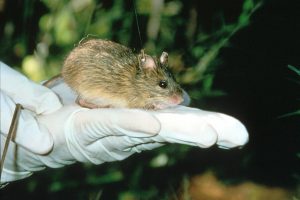The Preble’s meadow jumping mouse could slow construction of Greeley’s last, contentious section of its 30-mile water pipeline. However, the mouse will have to get in line behind other delaying forces.
In late August, U.S. Fish & Wildlife Service officials decided that Greeley must develop a plan to restore habitat for the Preble’s mouse, which is protected under the U.S. Endangered Species Act, after pipeline construction is completed.
Biologist Peter Plage with the agency’s Colorado office said such a plan usually involves re-vegetation of the disturbed area. The final 6½-mile segment of the pipeline runs from North Shields Street to Greeley’s treatment plant in Bellvue, with a portion of the pipe going through LaPorte.

The Preble’s jumping mouse has been trapped in the past at Watson Lake near Bellvue, Plage said. Once the mouse has been found in an area, it is assumed to be present there in future years.
Greeley had hoped to avoid the mouse habitat issue, claiming that its project would have no adverse effect on the critter. However, Plage said, the city reported that 40 acres of suitable mouse habitat would be disturbed by construction. “That’s above the level of ‘no effect,’” he said.
Normally, Plage said, an endangered species habitat plan can be approved by Fish & Wildlife within a month, but in this case the mouse issue will have to wait.
The U.S. Army Corps of Engineers, permitting agency for the pipeline, wants to complete its study of water depletion in the Cache la Poudre River before it addresses the Preble’s issue. The study will, among other things, project changes to habitat along the river caused by reduced river flow. Those changes could affect mouse habitat, so the Army Corps wants to take a look at that information.
“They prefer having the complete picture first,” said Plage.
The Army Corps’ water depletion study looks at the combined effects of three planned water projects: the Greeley pipeline, expansion of Halligan and Seaman reservoirs and the Northern Integrated Supply Project, which includes the proposed Glade Reservoir.
In addition to the study and the mouse, Greeley’s project has other obstacles to deal with before construction can start. For one, the Army Corps must decide whether Greeley needs a nationwide or individual permit for the last segment of pipeline. That decision will hinge on whether or not the project is determined to have a substantial environmental impact.
If the agency decides that the impact is substantial, it will require an individual permit, requiring more extensive analysis and a public comment period.
Finally, the city still has to deal with angry LaPorte-area landowners who do not want to grant easements for the pipeline through their property. Project director Dan Moore said 16 of the necessary 24 easements have been obtained and the city is trying to negotiate with the remaining property owners.
“There may be some cases where the matter is resolved in court,” with Greeley exercising its power of eminent Moore said.
“Certainly we would go to court,” said LaPorte resident Rose Brinks, “not for amount of compensation but for their right to tear up our land. They have other options. Greeley needs to start over and this time listen to the people of LaPorte and Bellvue, not just dictate what Greeley wants and is cheapest for them.”
Brinks’ neighbor Mary Humstone said it is “premature for Greeley to talk about obtaining easements when they don’t even have their permits in place for the pipeline.”
Greeley still hopes to start construction of the final pipeline section this winter. Moore said it’s preferable to work during the winter because there are rarely disruptions to irrigation and fewer disturbances to sensitive species, such as the Preble’s mouse.
However, the city is evaluating whether some work could be conducted in the spring or summer.
When complete, the 60-inch pipeline will deliver an additional 50 million gallons of water per day to Greeley. The water will come out of the Poudre River, using water rights owned by the city.
Support Northern Colorado Journalism
Show your support for North Forty News by helping us produce more content. It's a kind and simple gesture that will help us continue to bring more content to you.
BONUS - Donors get a link in their receipt to sign up for our once-per-week instant text messaging alert. Get your e-copy of North Forty News the moment it is released!
Click to Donate

